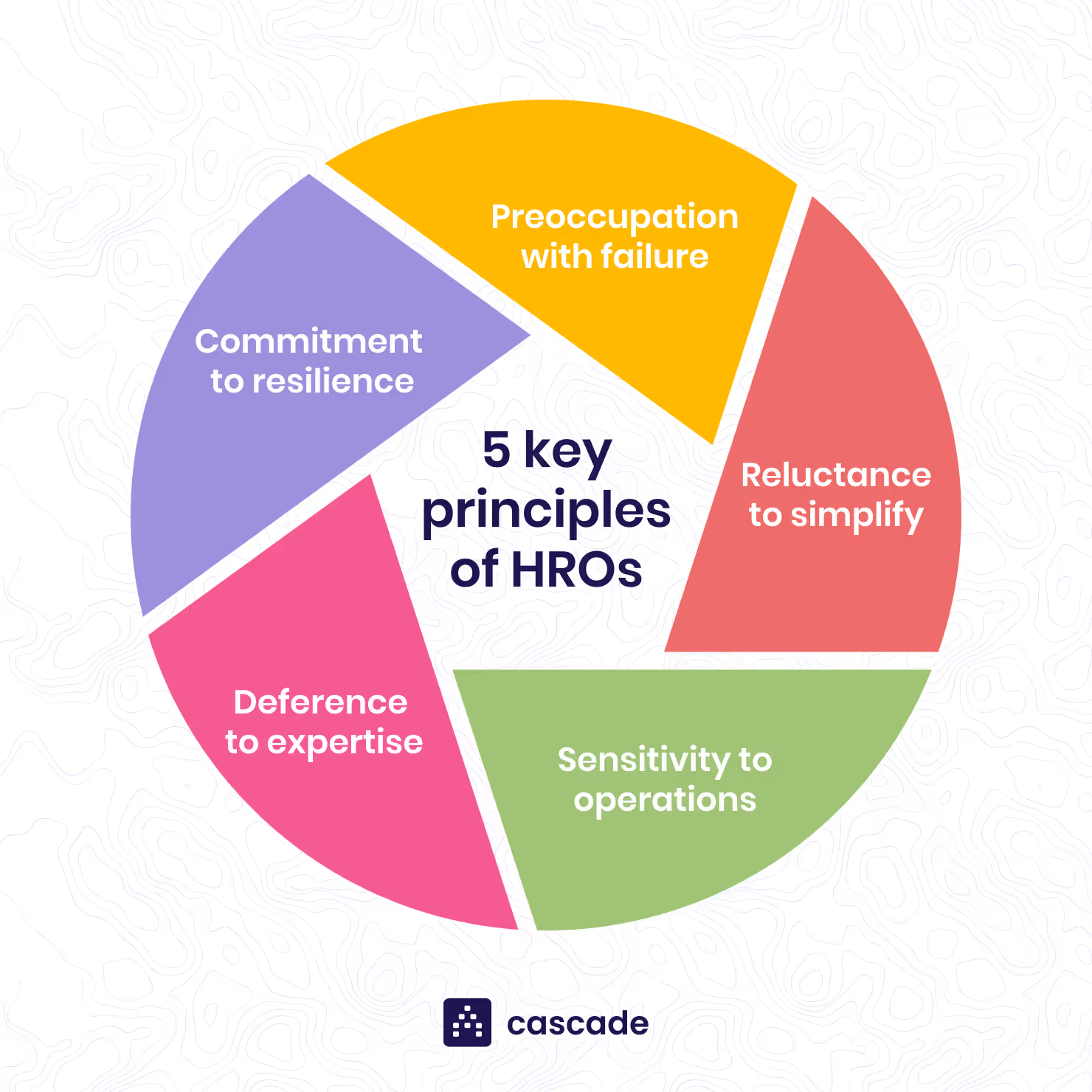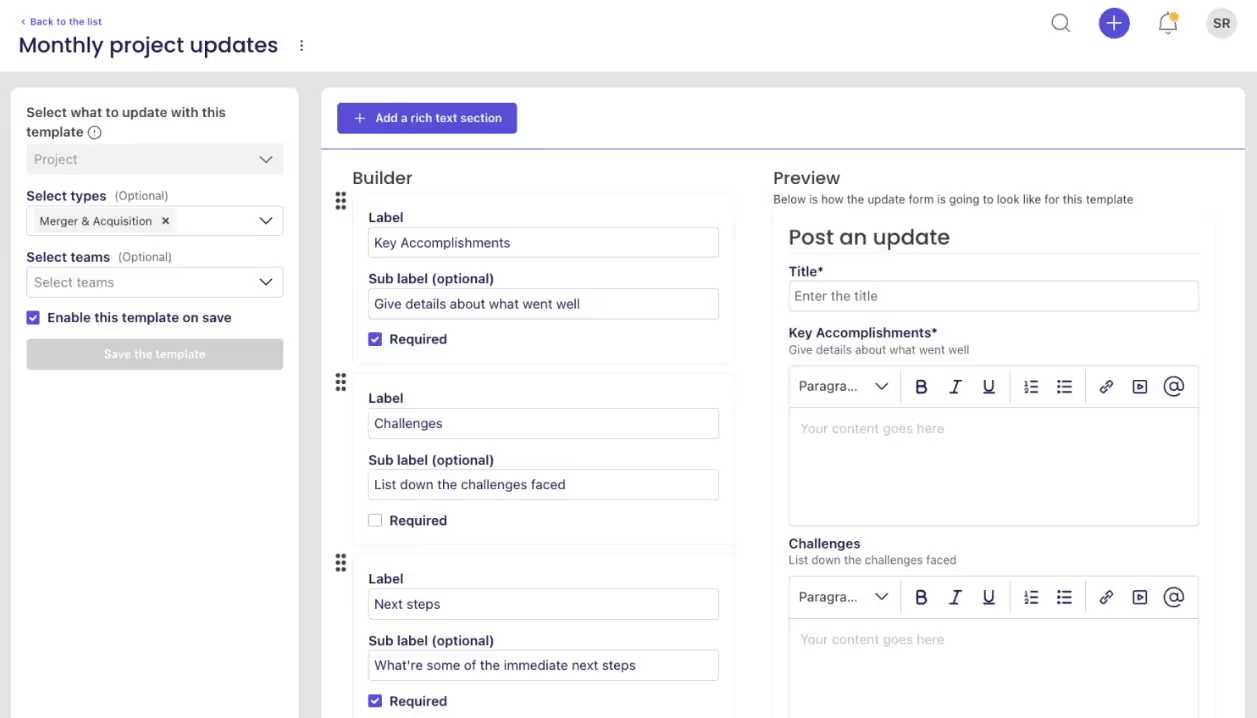Ever wonder why a 150-ton flying machine became the world's safest transportation? It’s an incredible achievement—and it’s possible because of the concept of high-reliability organizations (HROs).
HROs are remarkable for achieving consistent excellence in the face of complex and high-risk environments. From healthcare to aerospace, the concept of HROs has found its foothold in industries where precision and safety stand in the way of catastrophes.
However, the principles and strategies that underlie HROs have a broader application. In this article, we’ll extract insights from HRO practices and dive into a concrete example where Cascade helped an organization implement HRO-related strategies. You’ll see how HRO principles can help you improve processes, achieve excellence, and reach organizational goals.
We’ll cover:
- What Is A High-Reliability Organization?
- 5 Key Principles Of HROs
- 5 Common HRO Implementation Strategies
- Case Study: How Cascade Solves Challenges For An HRO
- Become A High-Reliability Organization With Cascade 🚀
What Is A High-Reliability Organization?
A high-reliability organization (HRO) is an entity that operates in complex and high-risk environments while consistently delivering impeccable results and avoiding accidents that would cause harm.
HRO theory prioritizes safety, resilience, and error reduction as core values. It creates a culture of accountability and allows the organization to navigate difficult situations with precision and situational awareness.
HROs strive to create a system where problems can be solved by everyone. In doing so, they empower people with centralized observability of the organization and procedures they should employ in case of a problem.
HRO principles provide benchmarks across various industries—most notably aviation, healthcare, nuclear power, emergency services, and the military.
5 Key Principles Of HROs
Let's explore these principles of high reliability and how they translate into broader business contexts.

#1 Preoccupation with failure
In an HRO, there's a constant focus on identifying potential failures or even near misses before they escalate into critical incidents. This principle encourages a proactive approach to risk management and problem-solving by all employees within the organization. It’s not about achieving improvements one project at a time, but rather making zero harm a natural byproduct of how organizations operate and do business.
💡Example: In healthcare, this could mean adopting stringent safety protocols workers must abide by to prevent medical errors or burnout. In manufacturing, daily huddles involving production and quality control teams can foster proactive teamwork that identifies potential defects early, ensuring high-quality output.
#2 Reluctance to simplify
HROs understand that oversimplifying complex situations can lead to misunderstandings and errors. They value in-depth analysis and appreciate the intricate nature of their operations. They embrace that complex problems might need complex solutions.
💡Example: Pharmaceutical companies dealing with medications often have complex global supply chains. They cannot afford to simplify logistics and distribution. They employ advanced tracking systems, quality control measures, and stringent storage conditions to ensure the safe and timely delivery of life-saving drugs. This approach minimizes the risk of medication shortages or compromised product quality.
#3 Sensitivity to operations
Being highly attuned to day-to-day operations is critical for HROs. Leaders work closely with frontline workers who often have invaluable insights into operational challenges and opportunities. This means that even minor deviations from the norm are acknowledged and addressed promptly to achieve zero harm.
💡Example: In aviation, even small irregularities are taken seriously to prevent potential accidents. Business leaders in other industries can adopt this mindset by valuing employees’s insights closest to the execution on the ground. Manufacturers could improve production processes by encouraging feedback from workers responsible for product assembly.
#4 Commitment to resilience
HROs prioritize building systems that can withstand unexpected disruptions and safety issues. They anticipate and prepare for troublesome events. This prepares organizations to navigate economic downturns, market shifts, or technological disruptions.
💡Example: In healthcare, this might involve disaster response plans for situations like pandemics. In a broader business context, leaders can cultivate resilience by diversifying supply chains to mitigate risks of disruptions or have multiple revenue streams to reduce dependency on a single product or service.
#5 Deference to expertise
HROs recognize that expertise resides at all levels of the organization and value it over authority. They empower workers with specialized knowledge or relevant experience to voice concerns and contribute insights. This practice enhances decision-making and overall operations.
💡Example: Manufacturing companies often form cross-functional teams where experts from different departments collaborate to identify and implement quality improvement measures. Such teams acknowledge that expertise exists throughout the organization and should be used for efficient problem-solving.
5 Common HRO Implementation Strategies
Implementing the principles of HROs requires concrete strategies that transform theory into actions and drive an organizational culture of excellence and reliability.
%20(1).avif)
Let's delve into 5 common HRO implementation strategies and their potential applications:
#1 Leadership development
A cornerstone of HRO success is effective leadership that champions the principles at every level. Organizations should train and develop individuals with the skills to navigate complexity, drive strategic alignment, and ensure accountability. This strategy transcends industries, reminding us that leadership is a universal catalyst for organizational success.
💡Example: In healthcare organizations, zero harm is a natural byproduct of how they take care of patients every day. Following this, medical directors and department leaders learn how to implement change management to facilitate HRO principles for all workers and team members. That’s how they enhance the ability of the whole institution to manage complex medical cases, ensure evidence-based practices, improve care delivery, and effectively communicate about even the smallest things that seem off at any level. By developing leadership skills that trickle down and empower everyone, healthcare organizations improve patient care and patient safety as well as reduce the risk of patient harm.
#2 Culture of safety
Creating a culture of safety means instilling a mindset where employees can raise concerns without fear of reprisal. A culture of safety is vital for ensuring a secure, productive environment across diverse industries.
💡Example: In the manufacturing sector, encouraging workers to report potential safety hazards without hesitation fosters an environment where everyone's input is valued, and employees' safety and well-being are actively prioritized.
#3 Data systems
By harnessing data for predictive insights, risk assessment, and process optimization, HROs chart a course toward reliability, resilience, and sustainable growth.
💡Example: In transportation, utilizing real-time tracking and monitoring of vehicles ensures efficient routes, maintenance schedules, and compliance with safety regulations. Data-driven insights enable companies to optimize operations, reduce fuel consumption, and enhance overall transportation reliability.
#4 Training and learning
Continuous training ensures that employees are well-versed in HRO principles and their applications. By equipping employees with the knowledge and skills to respond adeptly to unforeseen challenges, organizations cultivate a culture of adaptability and resilience.
💡Example: In the hospitality sector, hotel staff undergo regular training on handling unexpected situations with grace and professionalism, mirroring the preparedness exhibited by HROs in critical scenarios.
#5 Implementing interventions
Implementing interventions involves proactively addressing potential failures before they escalate. By fine-tuning processes, identifying weak points, and executing interventions with precision, organizations across industries ensure continuous improvement, operational excellence, and ultimately, reliability.
💡Example: In the IT sector, taking proactive cybersecurity measures includes conducting regular simulated phishing exercises to educate employees about potential email threats. Additionally or deploying intrusion detection systems.
By implementing these strategies, organizations can bridge the gap between theory and practice, effectively embedding the principles of HROs into their operations.
Case Study: How Cascade Solves Challenges For An HRO
The core tenets of HROs emphasize trackability, systems, visibility, and accountability, but many organizations are facing challenges in these areas. For such organizations, Cascade can serve as a platform that enhances alignment and observability as well as provides a centralized space for ongoing strategy execution and process improvement.
In this case study, we’ll show you how Cascade helps solve the challenges of high-reliability healthcare for a large regional health system.
The organization in question employs more than 29,000 employees and has 4,600 affiliated healthcare providers offering primary and specialty care at 11 hospitals, in more than 150 locations.
Let’s examine their 3 core challenges and how Cascade solves them.
Challenge #1: Organizational alignment
Achieving organizational alignment is particularly challenging in HROs with complex, multi-unit structures.
In our example, 11 hospitals operate as separate entities. Despite their affiliation, these hospitals retain their own C-suite leadership and board of directors, reflecting semi-autonomous business units within the broader health system.
At the system level, the joint commission creates a three-year system strategy.
However, each hospital also creates its annual operating plan (AOP), involving its respective strategy teams, healthcare leaders, and boards. This structure presents the challenge of aligning strategic objectives among these disparate units.
Even with well-defined targets, differences in tracking methods, manual status updates, and disparate information flow create inconsistencies in alignment and visibility.
The big question is: How do we make these disparate parts of a system work towards the same goals and have the same focus?
💡The Cascade solution: Connecting high-level strategy and objectives
For our customer, achieving robust organizational alignment became a pivotal focus.
Cascade offered a solution that streamlined the alignment journey. The health system decided it was going to focus on 7 key areas. Once these 7 areas were visible in Cascade, it enabled everyone across all member organizations of the system to craft their AOP around these focus areas and strategic priorities.
Cascade allowed hospitals to create individual plans with hospital-specific tactics, objectives, initiatives, and key measures and easily connect them with the focus areas and the high-level strategy.
While the member organizations retained their autonomy in setting AOP targets, Cascade bridged the gap between the overarching system-level strategy and the individual AOPs of individual units. It provided everyone with the objective alignment map which gave them a clear visual context of how aligned their objectives were with the organizational strategy horizontally and vertically.
%20(1).png)
Such streamlining of strategy planning and execution is a pathway to alignment and progress tracking, bringing unity to diverse entities operating within the same framework.
📚 Recommended read: How To Create An Effective Annual Operating Plan (+Template)
Challenge #2: Accountability and governance
Healthcare staff are immersed in critical tasks. Balancing time-sensitive duties with strategic focus becomes tough, emphasizing the need for a solution that instills accountability.
The challenge this organization and many other HROs face is eliminating redundant efforts, establishing a connection across multiple touchpoints, and ensuring essential updates reach the right people.
💡The Cascade solution: An easier way of establishing and distributing accountability
Cascade offers a comprehensive solution to address accountability challenges within complex healthcare systems. It makes it easier to see who’s responsible for what, assign key roles, observe progress, and visualize how different objectives connect to high-level strategy. It also makes it simpler and faster to create updates and reports.
In the case of the organization in question, everything mentioned above made it easier to create greater ownership through leadership buy-in. Now the VPs and directors use the platform and own their updates, setting an example for all employees.
This provides two main benefits:
- It gets crucial leadership endorsement. Commitment from the C-suite facilitates strategic execution and cascades accountability down the hierarchy, creating a culture of responsibility.
- It disperses responsibility, distributes the workload more effectively, and creates more individual accountability. It means that a strategy manager is not responsible for collecting all the updates as it too often happens.
A specific example of Cascade's capabilities is its structured update templates. For institutions that constantly need up-to-date insights into their successes, challenges, and next steps this functionality is invaluable. The ability to structure and standardize these updates ensures that the right updates reach the right people, enhancing attention allocation and strategic execution.

By using Cascade, our customer infused accountability across various touchpoints and optimized its plans. It’s an efficient way of ensuring that HROs can spread true ownership and responsibility across the organizations and thus become more reliable.
Challenge #3: Centralized observability
The health system faced the challenge of achieving an integrated view encompassing multiple hospitals, their AOPs, and system departments. This involved creating a comprehensive system that seamlessly connected data, objectives, and insights from these diverse sources, all while ensuring complete visibility.
💡The Cascade solution: Consolidating all data and insights in one place
Cascade entered the stage as the orchestrator of centralized observability, immediately bringing together different strategic elements:
- Integrations that get all data from different sources into Cascade and streamline reporting.
- Tracking individual AOPs against system-level strategy, creating alignment, and tracking progress.
- Visibility into system departments that the health system decided to launch.
Integrations with tech tools clinicians use, such as SharePoint and Teams, were key to achieving centralized observability. These integrations mean that people are now working with a connected tech stack instead of siloed tools and data. They also automate essential reports and dashboards and ensure they are accurate throughout the organization.
By connecting core metrics with its reporting systems Cascade elevates tracking workflows and visibility by displaying key data in a centralized space. It showcases how data and objectives connect to the focus areas and the high-level strategy. This means people get data in context and can understand the story behind the numbers, which improves decision-making and is key for HROs.
These capabilities were crucial when our customer introduced system departments. These departments centralize specialized, functions like marketing and finance across the health system and all its member organizations.
Cascade supports them by making their work, projects, capabilities, and progress more transparent, which fosters a holistic understanding of their contributions. By making them observable in a central place it makes it clear the departments are working with the whole system and that they’re not just fragmented entities across specific hospitals.
.png)
Active staff participation is essential to achieve high reliability and ensure the effectiveness of the HRO approach. Cascade is there to provide the entire organization with viewing licenses and embedded dashboards that showcase progress.
Become A High-Reliability Organization With Cascade 🚀
The principles of HROs extend beyond their traditional domains, offering valuable insights for all businesses. We can all learn valuable lessons from organizations that operate with precision and safety in complex and high-risk environments.
Cascade has proven it has the needed capabilities to infuse HRO principles into an organization's DNA. By addressing challenges in alignment, accountability, and visibility, Cascade empowers organizations to proactively manage risks, streamline processes, achieve centralized observability, and accomplish excellence in their respective industries.
If you’re looking to implement HRO principles, sign up today for a free forever plan or book a guided 1:1 product tour with one of our Cascade in-house strategy execution experts.






.png)
.jpg)
.jpg)
%20(1)%20(1)%20(1)%20(1)%20(1).png)



